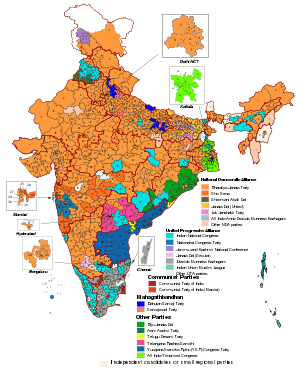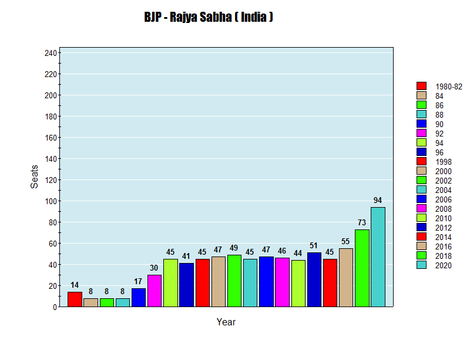Bharatiya Janata Party
The Bharatiya Janata Party (pronounced [bʱaːrətiːjə dʒənətaː paːrʈiː] (![]()
Bharatiya Janata Party | |
|---|---|
 | |
| Abbreviation | BJP |
| President | Jagat Prakash Nadda[1] |
| General Secretary | B. L. Santhosh[2] |
| Presidium | National Executive[3] |
| Parliamentary Chairperson | Narendra Modi (Prime Minister) |
| Lok Sabha leader | Narendra Modi (Prime Minister)[4] |
| Rajya Sabha leader | Thawar Chand Gehlot (Minister of Social Justice and Empowerment)[4] |
| Founder | [5] |
| Founded | 6 April 1980[6] |
| Split from | Janata Party[6] |
| Preceded by |
|
| Headquarters | 6-A, Deen Dayal Upadhyaya Marg, New Delhi-110002[7] |
| Newspaper | Kamal Sandesh[8] |
| Think tank | Public Policy Research Centre[9][10] Vivekananda International Foundation[11] |
| Student wing | Akhil Bharatiya Vidyarthi Parishad (unofficial)[12] |
| Youth wing | Bharatiya Janata Yuva Morcha[13] |
| Women's wing | BJP Mahila Morcha[14] |
| Labour wing | Bharatiya Mazdoor Sangh[15] |
| Peasant's wing | BJP Kisan Morcha[16] |
| Membership | |
| Ideology | Integral humanism[18] Hindutva[19] Conservatism[18] Social conservatism[20] National conservatism[21] Right-wing populism[22] Hindu nationalism[19] Economic nationalism[23] Cultural nationalism[24] |
| Political position | Right-wing[25] |
| International affiliation | |
| Colours | Saffron[29] |
| Slogan | The Party with a Difference |
| ECI Status | National Party[30] |
| Alliance | |
| Seats in Lok Sabha | 303 / 543 (currently 542 members and 1 vacancy)[33]
|
| Seats in Rajya Sabha | 86 / 245 (currently 241 members and 2 vacancies)[34][35]
|
| Seats in State Legislative Assemblies | 1,323 / 4,121
(currently 3983 members and 136 vacancies) (see complete list) |
| Seats in State Legislative Councils | 91 / 426
(currently 373 members and 53 vacancies) (see complete list) |
| Number of states and union territories in government | 18 / 31 (currently 28 states and 2 union territories)[36]
|
| Election symbol | |
 | |
| Website | |
| www | |
| This article is part of a series on the |
| Bharatiya Janata Party |
|---|
| About |
|
| Committees |
| Frontals |
The BJP's origin lies in the Bharatiya Jana Sangh, formed in 1951 by Syama Prasad Mukherjee.[43] After the State of Emergency in 1977, the Jana Sangh merged with several other parties to form the Janata Party; it defeated the incumbent Congress party in the 1977 general election. After three years in power, the Janata party dissolved in 1980 with the members of the erstwhile Jana Sangh reconvening to form the BJP. Although initially unsuccessful, winning only two seats in the 1984 general election, it grew in strength on the back of the Ram Janmabhoomi movement. Following victories in several state elections and better performances in national elections, the BJP became the largest party in the parliament in 1996; however, it lacked a majority in the lower house of Parliament, and its government lasted only 13 days.[44]
After the 1998 general election, the BJP-led coalition known as the National Democratic Alliance (NDA) under Prime Minister Atal Bihari Vajpayee formed a government that lasted for a year. Following fresh elections, the NDA government, again headed by Vajpayee, lasted for a full term in office; this was the first non-Congress government to do so. In the 2004 general election, the NDA suffered an unexpected defeat, and for the next ten years the BJP was the principal opposition party. Long time Gujarat Chief Minister Narendra Modi led it to a landslide victory in the 2014 general election. Since that election, Modi has led the NDA government as Prime Minister and as of February 2019, the alliance governs 18 states.
The official ideology of the BJP is integral humanism, first formulated by Deendayal Upadhyaya in 1965. The party expresses a commitment to Hindutva, and its policy has historically reflected Hindu nationalist positions. The BJP advocates social conservatism and a foreign policy centred on nationalist principles. Its key issues have included the abrogation of the special status to Jammu and Kashmir, the building of a Ram Temple in Ayodhya and the implementation of a uniform civil code. However, the 1998–2004 NDA government did not pursue any of these controversial issues. It instead focused on a largely liberal economic policy prioritising globalisation and economic growth over social welfare.[45]
History
Predecessors
Bharatiya Jana Sangh (1951–77)
The BJP's origins lie in the Bharatiya Jana Sangh, popularly known as the Jana Sangh, founded by Syama Prasad Mukherjee in 1951 in response to the politics of the dominant Congress party. It was founded in collaboration with the Hindu nationalist volunteer organisation, the Rashtriya Swayamsevak Sangh (RSS), and was widely regarded as the political arm of the RSS.[46] The Jana Sangh's aims included the protection of India's "Hindu" cultural identity, in addition to countering what it perceived to be the appeasement of Muslim people and the country of Pakistan by the Congress party and then-Prime Minister Jawaharlal Nehru. The RSS loaned several of its leading pracharaks, or full-time workers, to the Jana Sangh to get the new party off the ground. Prominent among these was Deendayal Upadhyaya, who was appointed General Secretary. The Jana Sangh won only three Lok Sabha seats in the first general elections in 1952. It maintained a minor presence in parliament until 1967.[47][48]
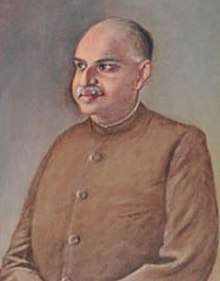
The Jana Sangh's first major campaign, begun in early 1953, centred on a demand for the complete integration of Jammu and Kashmir into India.[49] Mookerjee was arrested in May 1953 for violating orders from the state government restraining him from entering Kashmir. He died of a heart attack the following month, while still in jail.[49] Mauli Chandra Sharma was elected to succeed Mookerjee; however, he was forced out of power by the RSS activists within the party, and the leadership went instead to Upadhyaya. Upadhyay remained the General Secretary until 1967, and worked to build a committed grassroots organisation in the image of the RSS. The party minimised engagement with the public, focusing instead on building its network of propagandists. Upadhyaya also articulated the philosophy of integral humanism, which formed the official doctrine of the party.[50] Younger leaders, such as Atal Bihari Vajpayee and Lal Krishna Advani also became involved with the leadership in this period, with Vajpayee succeeding Upadhyaya as president in 1968. The major themes on the party's agenda during this period were legislating a uniform civil code, banning cow slaughter and abolishing the special status given to Jammu and Kashmir.[51]
After assembly elections across the country in 1967, the party entered into a coalition with several other parties, including the Swatantra Party and the socialists. It formed governments in various states across the Hindi heartland, including Madhya Pradesh, Bihar and Uttar Pradesh. It was the first time the Jana Sangh held political office, albeit within a coalition; this caused the shelving of the Jana Sangh's more radical agenda.[52]
Janata Party (1977–80)
In 1975, Prime Minister Indira Gandhi imposed a state of emergency. The Jana Sangh took part in the widespread protests, with thousands of its members being imprisoned along with other agitators across the country. In 1977, the emergency was withdrawn and general elections were held. The Jana Sangh merged with parties from across the political spectrum, including the Socialist Party, the Congress (O) and the Bharatiya Lok Dal to form the Janata Party, with its main agenda being defeating Indira Gandhi.[48]
The Janata Party won a majority in 1977 and formed a government with Morarji Desai as Prime Minister. The former Jana Sangh contributed the largest tally to the Janata Party's parliamentary contingent, with 93 seats or 31% of its strength. Vajpayee, previously the leader of the Jana Sangh, was appointed the Minister of External Affairs.[53]
The national leadership of the former Jana Sangh consciously renounced its identity, and attempted to integrate with the political culture of the Janata Party, based on Gandhian and Hindu traditionalist principles. According to Christophe Jaffrelot, this proved to be an impossible assimilation.[54] The state and local levels of the Jana Sangh remained relatively unchanged, retaining a strong association with the RSS, which did not sit well with the moderate centre-right constituents of the Party.[55] Violence between Hindus and Muslims increased sharply during the years that the Janata Party formed the government, with former Jana Sangha members being implicated in the riots at Aligarh and Jamshedpur in 1978–79. The other major constituents of the Janata Party demanded that the Jana Sangh should break from the RSS, which the Jana Sangh refused to do. Eventually, a fragment of the Janata Party broke off to form the Janata Party (Secular). The Morarji Desai government was reduced to a minority in the Parliament, forcing its resignation. Following a brief period of coalition rule, general elections were held in 1980, in which the Janata Party fared poorly, winning only 31 seats. In April 1980, shortly after the elections, the National Executive Council of the Janata Party banned its members from being 'dual members' of party and the RSS. In response, the former Jana Sangh members left to create a new political party, known as the Bharatiya Janata Party.[56][53]
BJP (1980–present)
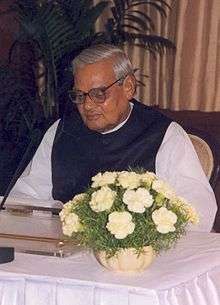
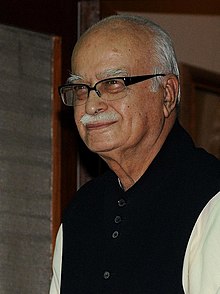
Formation and early days
Although the newly formed BJP was technically distinct from the Jana Sangh, the bulk of its rank and file were identical to its predecessor, with Vajpayee being its first president. Historian Ramachandra Guha writes that the early 1980s were marked by a wave of violence between Hindus and Muslims. The BJP initially moderated the Hindu nationalist stance of its predecessor the Jana Sangh to gain a wider appeal, emphasising its links to the Janata Party and the ideology of Gandhian Socialism.[57] This was unsuccessful, as it won only two Lok Sabha seats in the elections of 1984.[57] The assassination of Indira Gandhi a few months earlier resulted in a wave of support for the Congress which won a record tally of 403 seats, contributing to the low number for the BJP.[58]
Ram Janmabhoomi movement and the Hindutva policies
The failure of Vajpayee's moderate strategy led to a shift in the ideology of the party toward a policy of more hardline Hindu nationalism.[57][59] In 1984, Advani was appointed president of the party, and under him it became the political voice of the Ram Janmabhoomi movement. In the early 1980s, the Vishwa Hindu Parishad (VHP) began a campaign for the construction of a temple dedicated to the Hindu deity Rama at the disputed site of the Babri Mosque in Ayodhya. The mosque had been constructed by the Mughal Emperor Babur in 1527. There is a dispute about whether a temple once stood there.[60] The agitation was on the basis of the belief that the site is the birthplace of Rama, and that a temple had been demolished to construct the mosque.[61] The BJP threw its support behind this campaign, and made it a part of their election platform. It won 86 Lok Sabha seats in 1989, a tally which made its support crucial to the National Front government of V. P. Singh.[62]
In September 1990, Advani began a rath yatra (chariot journey) to Ayodhya in support of the Ram temple movement. According to Guha, the imagery employed by the yatra was "religious, allusive, militant, masculine, and anti-Muslim", and the speeches delivered by Advani during the yatra accused the government of appeasing Muslims and practising "pseudo-secularism" that obstructed the legitimate aspirations of Hindus.[63] Advani defended the yatra, stating that it had been free of incident from Somnath to Ayodhya, and that the English media were to blame for the violence that followed.[64] Advani was placed under preventive detention on the orders of the then Bihar chief minister Lalu Prasad Yadav. A large number of kar sevaks nonetheless converged at Ayodhya. On the orders of Uttar Pradesh chief minister Mulayam Singh Yadav, 150,000 of them were detained, yet half as many managed to reach Ayodhya and some attacked the mosque. Three days of fighting with the paramilitary forces ended with the deaths of several kar sevaks. Hindus were urged by VHP to "take revenge" for these deaths, resulting in riots against Muslims across Uttar Pradesh. [65] The BJP withdrew its support from the V.P. Singh government, leading to fresh general elections. It once again increased its tally, to 120 seats, and won a majority in the Uttar Pradesh assembly.[66]
On 6 December 1992, the RSS and its affiliates organised a rally involving more than 100,000 VHP and BJP activists at the site of the mosque.[66] Under circumstances that are not entirely clear, the rally developed into a frenzied attack that ended with the demolition of the mosque.[66] Over the following weeks, waves of violence between Hindus and Muslims erupted all over the country, killing over 2,000 people.[66] The government briefly banned the VHP, and many BJP leaders, including Advani were arrested for making inflammatory speeches provoking the demolition.[67][68] Several historians have said that the demolition was the product of a conspiracy by the Sangh Parivar, and not a spontaneous act.[66]
A 2009 report, authored by Justice Manmohan Singh Liberhan, found that 68 people were responsible for the demolition, mostly leaders from the BJP.[68] Among those named were Vajpayee, Advani, and Murli Manohar Joshi. The report also criticised Kalyan Singh, Chief Minister of Uttar Pradesh during the demolition.[68] He was accused of posting bureaucrats and police officers who would stay silent during the demolition.[68] Anju Gupta, an Indian Police Service officer in charge of Advani's security, appeared as a prominent witness before the commission. She said that Advani and Joshi made provocative speeches that were a major factor in the mob's behaviour.[69]
In the parliamentary elections in 1996, the BJP capitalised on the communal polarisation that followed the demolition to win 161 Lok Sabha seats, making it the largest party in parliament.[44] Vajpayee was sworn in as Prime Minister, but was unable to attain a majority in the Lok Sabha, forcing the government to resign after 13 days.[44]
NDA government (1998–2004)
A coalition of regional parties formed the government in 1996, but this grouping was short lived, and mid-term polls were held in 1998. The BJP contested the elections leading a coalition called the National Democratic Alliance (NDA), which contained its existing allies like the Samata Party, the Shiromani Akali Dal, the Shiv Sena in addition to the All India Anna Dravida Munnetra Kazhagam (AIADMK) and the Biju Janata Dal. Among these regional parties, the Shiv Sena was the only one which had an ideology similar to the BJP; Amartya Sen, for example, called the coalition an "ad hoc" grouping.[70][71] The NDA had a majority with outside support from the Telugu Desam Party (TDP) and Vajpayee returned as Prime Minister.[72] However, the coalition ruptured in May 1999 when the leader of AIADMK, Jayalalitha, withdrew her support, and fresh elections were held again.[73]
On 13 October 1999, the NDA, without the AIADMK, won 303 seats in parliament and thus an outright majority. The BJP had its highest ever tally of 183. Vajpayee became Prime Minister for the third time; Advani became Deputy Prime Minister and Home Minister. This NDA government lasted its full term of five years. Its policy agenda included a more aggressive stance on defence and terror as well as neo-liberal economic policies.[45]
In 2001, Bangaru Laxman, then the BJP president, was filmed accepting a bribe of ₹100,000 (equivalent to ₹320,000 or US$4,500 in 2019)[74] to recommend the purchase of hand-held thermal imagers for the Indian Army to the Defence Ministry, in a sting operation by Tehelka journalists.[75][76] The BJP was forced to make him resign and he was subsequently prosecuted. In April 2012, he was sentenced to four years in prison.[77]
2002 Gujarat violence
On 27 February 2002, a train carrying Hindu pilgrims was burned outside the town of Godhra, killing 59 people. The incident was seen as an attack upon Hindus, and sparked off massive anti-Muslim violence across the state of Gujarat that lasted several weeks.[78] The death toll estimated was as high as 2000, while 150,000 were displaced.[79] Rape, mutilation, and torture were also widespread.[79][80] The then-Gujarat chief minister Narendra Modi and several high-ranking government officials were accused of initiating and condoning the violence, as were police officers who allegedly directed the rioters and gave them lists of Muslim-owned properties.[81] In April 2009, a Special Investigation Team (SIT) was appointed by the Supreme Court to investigate and expedite the Gujarat riots cases. In 2012, Modi was cleared of complicity in the violence by the SIT and BJP MLA Maya Kodnani, who later held a cabinet portfolio in the Modi government, was convicted of having orchestrated one of the riots and sentenced to 28 years imprisonment;[82][83] she was later acquitted by the Gujarat High Court.[84] Scholars such as Paul Brass, Martha Nussbaum and Dipankar Gupta have said that there was a high level of state complicity in the incidents.[85][86][87]
General election defeats
Vajpayee called for early elections in 2004, six months ahead of schedule. The NDA's campaign was based on the slogan "India Shining", which sought to depict it as responsible for a rapid economic transformation of the country.[88] However, the NDA unexpectedly suffered a heavy defeat, winning only a 186 seats in the Lok Sabha, compared to the 222 of the Congress and its allies. Manmohan Singh succeeded Vajpayee as Prime Minister as the head of the United Progressive Alliance. The NDA's failure to reach out to rural Indians was provided as an explanation for its defeat, as was its divisive policy agenda.[88][89]
In May 2008, the BJP won the state elections in Karnataka. This was the first time that the party won assembly elections in any South Indian state. In the 2009 general elections, its strength in the Lok Sabha was reduced to 116 seats. It lost the Karnataka assembly election in 2013.[90]
NDA government (2014–present)

In the 2014 Indian general election, the BJP won 282 seats, leading the NDA to a tally of 336 seats in the 543-seat Lok Sabha.[91] Narendra Modi was sworn in as the 14th Prime Minister of India on 26 May 2014.[92][93]
The vote share of the BJP was 31% of all votes cast, a low figure relative to the number of seats it won.[94] This was the first instance since 1984 of a single party achieving an outright majority in the Indian Parliament[95] and the first time that it achieved a majority in the Lok Sabha on its own strength. Support was concentrated in the Hindi-speaking belt in North-central India.[94] The magnitude of the victory was not predicted by most opinion and exit polls.[94]
Political analysts have suggested several reasons for this victory, including the popularity of Modi, and the loss of support for the Congress due to the corruption scandals in its previous term.[96] The BJP was also able to expand its traditionally upper-caste, upper-class support base and received significant support from middle-class and Dalit people, as well as among Other Backward Classes.[97][94] Its support among Muslims remained low; only 8% of Muslim voters voted for the BJP.[97][94] The BJP was also very successful at mobilising its supporters, and raising voter turnout among them.[94]
In 2019, the BJP won the general election with a majority. Soon after coming to power, on 5 August 2019, the Modi administration revoked the special status, or limited autonomy, granted under Article 370 of the Indian Constitution to Jammu and Kashmir—a region administered by India as a state and this states consists of the larger part of Kashmir which has been the subject of dispute among India, Pakistan, and China since 1947.[98][99]
Later in 2019, the Modi administration introduced the Citizenship (Amendment) Act, 2019, which was passed by the Parliament of India on 11 December 2019. It amended the Citizenship Act, 1955 by providing a path to Indian citizenship for illegal migrants of Hindu, Sikh, Buddhist, Jain, Parsi, and Christian religious minorities, who had fled persecution from Pakistan, Bangladesh and Afghanistan before December 2014.[100][101] Muslims from those countries were not given such eligibility.[102] The act was the first time religion had been overtly used as a criterion for citizenship under Indian law.[102][lower-alpha 1][lower-alpha 2][lower-alpha 3]
General election results
The Bharatiya Janata Party was officially founded in 1980, and the first general election it contested was in 1984, in which it won only two Lok Sabha seats. Following the election in 1996, the BJP became the largest party in the Lok Sabha for the first time, but the government it formed was short-lived.[44] In the elections of 1998 and 1999, it remained the largest party, and headed the ruling coalition on both occasions.[45] In the 2014 general election, it won an outright majority in parliament. From 1991 onwards, a BJP member has led the Opposition whenever the party was not in power.[103] For the electoral results of the BJP's predecessors, see the JP and BJS articles.
| Year | Legislature | Party leader | Seats won | Change in seats | Percentage of votes | Vote swing | Outcome | Ref. |
|---|---|---|---|---|---|---|---|---|
| 1984 | 8th Lok Sabha | Lal Krishna Advani | 2 / 533 |
7.74% | – | Opposition | [104] | |
| 1989 | 9th Lok Sabha | Lal Krishna Advani | 85 / 545 |
11.36% | Outside support for NF | [105] | ||
| 1991 | 10th Lok Sabha | Lal Krishna Advani | 120 / 545 |
20.11% | Opposition | [106] | ||
| 1996 | 11th Lok Sabha | Atal Bihari Vajpayee | 161 / 545 |
20.29% | Government, later opposition | [107] | ||
| 1998 | 12th Lok Sabha | Atal Bihari Vajpayee | 182 / 545 |
25.59% | Government | [108] | ||
| 1999 | 13th Lok Sabha | Atal Bihari Vajpayee | 182 / 545 |
23.75% | Government | [109] | ||
| 2004 | 14th Lok Sabha | Atal Bihari Vajpayee | 138 / 543 |
22.16% | Opposition | [110] | ||
| 2009 | 15th Lok Sabha | Lal Krishna Advani | 116 / 543 |
18.80% | Opposition | [111] | ||
| 2014 | 16th Lok Sabha | Narendra Modi | 282 / 543 |
31.34% | Government | [112] | ||
| 2019 | 17th Lok Sabha | Narendra Modi | 303 / 543 |
37.46% | Government | [113] |
Ideology and political positions
| Part of a series on |
| Conservatism |
|---|
 |
|
Concepts
|
|
Organizations
|
|
Religious conservatism
|
|
National variants |
|
| Part of a series on |
| Nationalism |
|---|
|
Core values |
|
|
Organizations |
|
Related concepts
|
|
Social policies and Hindutva
The official philosophy of the BJP is "Integral humanism," a philosophy first formulated by Deendayal Upadhyaya in 1965, who described it as advocating an "indigenous economic model that puts the human being at center stage."[114][115] It is committed to Hindutva, an ideology articulated by Indian independence activist Vinayak Damodar Savarkar. According to the party, Hindutva is cultural nationalism favouring Indian culture over westernisation, thus it extends to all Indians regardless of religion.[57] However, scholars and political analysts have called their Hindutva ideology an attempt to redefine India and recast it as a Hindu country to the exclusion of other religions, making it a Hindu nationalist party in a general sense.[66][57][116][117] The BJP has slightly moderated its stance after the NDA was formed in 1998, due to the presence of parties with a broader set of ideologies.[66][45]
The BJP's Hindutva ideology has been reflected in many of its government policies. It supports the construction of the Ram Temple at the disputed site of the Babri Mosque.[116] This issue was its major poll plank in the 1991 general elections.[116] However, the demolition of the mosque during a BJP rally in 1992 resulted in a backlash against it, leading to a decline of the temple's prominence in its agenda.[116] The education policy of the NDA government reorganised the National Council of Educational Research and Training (NCERT) and tasked it with extensively revising the textbooks used in Indian schools.[118] Various scholars have stated that this revision, especially in the case of history textbooks, was a covert attempt to "saffronise" Indian history.[118][119][120][121] The NDA government introduced Vedic astrology as a subject in college curricula, despite opposition from several leading scientists.[122]
Taking a position against what it calls the "pseudo-secularism" of the Congress party, the BJP instead supports "positive secularism".[116] Vajpayee laid out the BJP's interpretation of Mahatma Gandhi's doctrine of Sarvadharma Samabhava and contrasted it with what he called European secularism.[123] He had said that Indian secularism attempted to see all religions with equal respect, while European secularism was independent of religion, thus making the former more "positive".[124] The BJP supports a uniform civil code, which would apply a common set of personal laws to every citizen regardless of their personal religion, replacing the existing laws which vary by religious community. According to historian Yogendra Malik, this ignores the differential procedures required to protect the cultural identity of the Muslim minority.[57][116] The BJP favours the abrogation of Article 370 of the Constitution of India, which grants a greater degree of autonomy to the Jammu and Kashmir in recognition of the unusual circumstances surrounding its accession to the Indian Union.[57]
The BJP opposes illegal migration into India from Bangladesh.[117] The party states that this migration, mostly in the states of Assam and West Bengal, threatens the security, economy and stability of the country.[117] Academics have pointed out that the BJP refers to Hindu migrants from Bangladesh as refugees, and reserves the term "illegal" for Muslim migrants.[117] Academic Michael Gillan writes that this is an attempt to use an emotive issue to mobilise Hindu sentiment in a region where the party has not been historically successful.[117][125]
In 2013, the Supreme Court of India reinstated the controversial Section 377 of the Indian Penal Code, which, among other things, criminalises homosexuality. There was a popular outcry, although clerics, including Muslim religious leaders, stated that they supported the verdict.[126][127] BJP president Rajnath Singh said that the party supported section 377, because it believed that homosexuality was unnatural,[128] though its stand has softened after its victory in the 2014 general elections.[129] Senior party members including Arun Jaitley and Harsh Vardhan openly support the rights of gender and sexual minorities in India. Vanathi Srinivasan, a BJP leader from Tamil Nadu, launched the first book on LGBTQIA and Genderqueer in Tamil penned by Gopi Shankar Madurai.[130][131][132][133] However, other leading party figures, such as Subramanian Swamy, were strongly critical of the decision by the Supreme Court to strike down Section 377 in Navtej Singh Johar v. Union of India.[134]
Economic policies
The BJP's economic policy has changed considerably since its founding. There is a significant range of economic ideologies within the party. In the 1980s, like the Jana Sangh, it reflected the thinking of the RSS and its affiliates. It supported swadeshi (the promotion of indigenous industries and products) and a protectionist export policy. However, it supported internal economic liberalisation, and opposed the state-driven industrialisation favoured by the Congress.[135]
During the 1996 elections, the BJP shifted its stance away from protectionism and towards globalisation; its election manifesto recommended increasing foreign investment in priority sectors, while restricting it in others. When the party was in power in 1998, it shifted its policy even further in favour of globalisation. The tenure of the NDA saw an unprecedented influx of foreign companies in India.[135] This was criticised by the left parties and the BJP's affiliates (the RSS and the Swadeshi Jagran Manch).[135] The communist parties said that the BJP was attempting to appease the World Bank and the United States government through its neoliberal policies.[135] Similarly, the RSS stated that the BJP was not being true to its swadeshi ideology.[135]
The two NDA governments in the period 1998–2004 introduced significant deregulation and privatisation of government owned enterprises. It also introduced tariff-reducing measures. These reforms built off of the initial economic liberalisation introduced by the Congress government in the early 1990s.[136] India's GDP growth increased substantially during the tenure of the NDA. The 2004 campaign slogan India Shining was based on the party's belief that the free market would bring prosperity to all sectors of society.[137] After its unexpected defeat, commentators said that it was punished for neglecting the needs of the poor and focusing too much on its corporate allies.[88][89][138]
This shift in the economic policies of the BJP was also visible in state governments, especially in Gujarat, where the BJP held power for 16 years.[139] Modi's government, in power from 2002 to 2014, followed a strongly neo-liberal agenda, presented as a drive towards development.[140][141] Its policies have included extensive privatisation of infrastructure and services, as well as a significant rollback of labour and environmental regulations. While this was praised by the business community, commentators criticised it as catering to the BJP's upper class constituency instead of the poor.[140]
Upon his election as Prime Minister in 2014, Modi has largely continued the reformist approach of the last two NDA governments, but unlike Vajpayee, "prefers to bill himself as a messiah of the poor, and not as an economic liberaliser".[142] Modi has been described as taking a more economically populist approach on healthcare and agricultural policy.[143]
Defence and counterterrorism
Compared to the Congress, the BJP takes a more aggressive and nationalistic position on defence policy and terrorism.[144][145] The Vajpayee-led NDA government carried out nuclear weapons tests, and enacted the Prevention of Terrorism Act, which later came under heavy criticism.[144][145] It also deployed troops to evict infiltrators from Kargil, and supported the United States' War on Terror.[146]
Although previous Congress governments developed the capability for a nuclear weapons test, the Vajpayee government broke with India's historical strategy of avoiding it and authorised Pokhran-II, a series of five nuclear tests in 1998.[144] The tests came soon after Pakistan tested a medium-range ballistic missile. They were seen as an attempt to display India's military prowess to the world, and a reflection of anti-Pakistan sentiment within the BJP.[144]
The Vajpayee government ordered the Indian armed forces to expel the Pakistani soldiers occupying Kashmir territory, later known as the Kargil War.[147][148] Although the government was later criticised for the intelligence failures that did not detect Pakistani presence, it was successful in ousting them from the previously Indian-controlled territory.[147][148] The Vajpayee administration also offered political support to the US War on Terror, in the hope of better addressing India's issues with terrorism and insurgency in Kashmir. This led to closer defence ties with the US, including negotiations for the sale of weapons.[146]
After the terrorist attack on the Indian Parliament in December 2001, the NDA government passed the Prevention of Terrorism Act.[145] The aim of the act was to improve the government's ability to deal with terrorism.[145] It initially failed to pass in the Rajya Sabha; therefore, the NDA took the extraordinary step of convening a joint session of the Parliament, where the numerical superior Lok Sabha allowed the bill to pass.[145] The act was subsequently used to prosecute hundreds of people accused of terrorism.[145] However, it was criticised by opposition parties and scholars for being an infringement upon civil liberties, and the National Human Rights Commission of India stated that it had been used to target Muslims.[145] It was later repealed by the Congress-led UPA government in 2004.[149]
Foreign policy
The historical stance of the BJP towards foreign policy, like the Bharatiya Jana Sangh, was based on an aggressive Hindu nationalism combined with economic protectionism.[150] The Bharatiya Jana Sangh was founded with the explicit aim of reversing the partition of India; as a result, its official position was that the existence of Pakistan was illegitimate.[150] This antagonism toward Pakistan remains a significant influence on the BJP's ideology.[150][151] During the Cold War, the party and its affiliates strongly opposed India's long standing policy of non-alignment, and instead advocated closeness to the United States.[150]
The Vajpayee government's foreign policy in many ways represented a radical shift from BJP orthodoxy, while maintaining some aspects of it.[135][151] Its policy also represented a significant change from the Nehruvian idealism of previous governments, opting instead for realism.[152] His party criticised him for adopting a much more moderate stance with Pakistan. In 1998, he made a landmark visit to Pakistan, and inaugurated the Delhi–Lahore Bus service.[150] Vajpayee signed the Lahore Declaration, which was an attempt to improve Indo-Pakistani relations that deteriorated after the 1998 nuclear tests.[150] However, the presence of Pakistani soldiers and militants in the disputed Kashmir territory was discovered a few months later, causing the 1999 Kargil War. The war ended a couple of months later, with the expulsion of the infiltrators two months later, without any shift in the Line of Control that marked the de facto border between the two countries.[150] Despite the war, Vajpayee continued to display a willingness to engage Pakistan in dialogue. This was not well received among the BJP cadre, who criticised the government for being "weak".[150] This faction of the BJP asserted itself at the post-Kargil Agra summit, preventing any significant deal from being reached.[150]
Organisation and structure
President
The organisation of the BJP is strictly hierarchical, with the president being the highest authority in the party.[115] Until 2012, the BJP constitution mandated that any qualified member could be national or state president for a single three-year term.[115] This was amended to a maximum of two consecutive terms.[153]
National Executive
Below the president is the National Executive , which contains a variable number of senior leaders from across the country. It is the higher decision making body of the party. Its members are several vice-presidents, general-secretaries, treasurers and secretaries, who work directly with the president.[115] An identical structure, with an executive committee led by a president, exists at the state, regional, district and local level.[115]
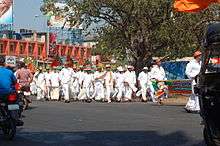
In April 2015, the BJP stated that it had more than 100 million registered members, which would make it the world's largest political party by primary membership.[154][155]
The BJP is a cadre-based party. It has close connections with other organisations with similar ideology, such as the RSS, ABVP, BYSS and the VHP. The cadres of these groups often supplement the BJP's. Its lower members are largely derived from the RSS and its affiliates, loosely known as the Sangh Parivar:[115]
- The Akhil Bharatiya Vidyarthi Parishad (All India Students' Union), the students' wing of the RSS.[115]
- The Bharatiya Kisan Sangh (Indian Farmer's Union), the farmers' division.[115]
- The Bharatiya Mazdoor Sangh (Indian Labourers Union), the labour union associated with the RSS.[115]
- The Bharatiya Yuva Seva Sangh (Youth Awakening Front), the Youth Awakening Front associated with the RSS.
The party has subsidiary organisations of its own, such as:
- The BJP Mahila Morcha (BJP Women's Front), its women's division.[115]
- The Bharatiya Janata Yuva Morcha (Indian People's Youth Front), its youth wing.[115]
- The BJP Minority Morcha (BJP Minority Front), its minority division.[115]
Presence in States and UTs
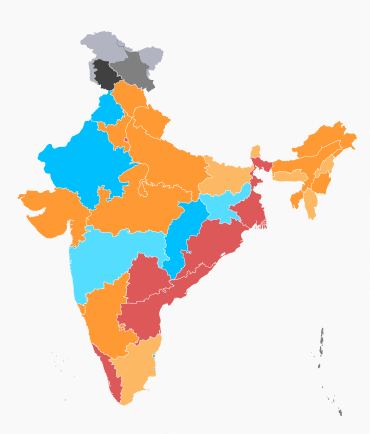
As of March 2020, the BJP holds a majority of Legislative Assembly in 12 states - Arunachal Pradesh, Assam, Goa, Gujarat, Himachal Pradesh, Karnataka, Madhya Pradesh, Manipur, Tripura, Uttar Pradesh and Uttarakhand. In Haryana, BJP shares power as the senior partner (Chief Minister of BJP) with Jannayak Janta Party.
Seats in State Legislative
In 8 other states, Andhra Pradesh, Bihar, Meghalaya, Mizoram, Nagaland, Odisha, Sikkim and Tamil Nadu (Although, BJP has not a single seat in Tamil Nadu Legislative Assembly) it shares power as Junior Partner with other political parties of the NDA coalition.
The BJP has previously been the sole party in power in Delhi, Chhattisgarh, Jharkhand and Rajasthan. It has also ruled Jammu and Kashmir, Maharashtra, Punjab and Puducherry as part of coalition governments.
The BJP has never been in power in 3 states-Kerala, Telangana (between 1999 and 2004 BJP in alliance with TDP ruled a United Andhra Pradesh) and West Bengal.
As of March 2020, the BJP has Chief Ministers in 12 states:
- Arunachal Pradesh (with Janata Dal (United) and National People's Party)
- Assam (with Asom Gana Parishad and Bodoland People's Front)
- Goa
- Gujarat
- Haryana (with Jannayak Janta Party)
- Himachal Pradesh
- Karnataka
- Madhya Pradesh
- Manipur (with Naga People's Front, National People's Party and Lok Janshakti Party)
- Tripura (with Indigenous People's Front of Tripura)
- Uttar Pradesh (with Apna Dal (Sonelal))
- Uttarakhand
In 5 other states, it shares power with other political parties. In all these states, the BJP is junior ally in the ruling alliance. The states are:
- Bihar (with Janata Dal (United) and Lok Janshakti Party)
- Meghalaya (with National People's Party, United Democratic Party, People's Democratic Front and Hill State People's Democratic Party)
- Mizoram (with Mizo National Front)
- Nagaland (with Nationalist Democratic Progressive Party)
- Sikkim (with Sikkim Krantikari Morcha)
In the state of Tamil Nadu, Bharatiya Janata Party supports the current rule of All India Anna Dravida Munnetra Kazhagam, although it has no occupied seats in the state legislature.[lower-alpha 4]
In the past, the BJP has also been the party in power in the following states and union territories:
- Chhattisgarh
- Delhi
- Rajasthan
- Maharashtra (with Shiv Sena)
- Jharkhand (with All Jharkhand Students Union)
It has been a part of the government in the following states and union territories as a junior ally being a part of coalition governments in the past:
- Andhra Pradesh (with Telugu Desam Party)
- Jammu and Kashmir (with Jammu and Kashmir Peoples Democratic Party)
- Odisha (with Biju Janata Dal)
- Punjab (with Shiromani Akali Dal)
It has never been a part of the government in the following states:
- Kerala
- Telangana (However, the BJP was an ally of Telugu Desam Party which administered the Telangana region as part of Andhra Pradesh before the state was bifurcated but it didn't join the government at that time)
- West Bengal
- Puducherry (However, the BJP was an ally of All India N.R. Congress when it was in power but it didn't join the government at that time)
It also has a regional political alliance in the Northeast India named as the North-East Democratic Alliance.[156][157][158][159]
List of Prime Ministers
| No. | Prime Ministers | Portrait | Term in Office | Lok Sabha | Constituency | |
|---|---|---|---|---|---|---|
| Term Start | Term End | |||||
| 1 | Atal Bihari Vajpayee |  |
16 May 1996 | 1 June 1996 | 11th | Lucknow |
| 19 March 1998 | 10 October 1999 | 12th | ||||
| 10 October 1999 | 22 May 2004 | 13th | ||||
| 2 | Narendra Modi |  |
26 May 2014 | 30 May 2019 | 16th | Varanasi |
| 30 May 2019 | (Incumbent) | 17th | ||||
List of Chief Ministers
As of March 2020, 43 people from Bharatiya Janata Party have held the position of a chief minister, out of which 12 are incumbent.
| S.No | Name | Portrait | State | Cabinet | Current Government Coalition |
|---|---|---|---|---|---|
| 1. | Pema Khandu | 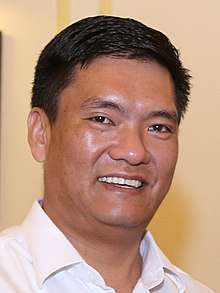 |
Arunachal Pradesh | Pema Khandu II | |
| 2. | Sarbananda Sonowal | 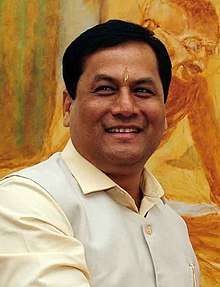 |
Assam | Sarbananda Sonowal I | |
| 3. | Pramod Sawant | 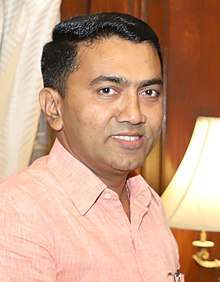 |
Goa | Pramod Sawant I |
|
| 4. | Vijay Rupani | 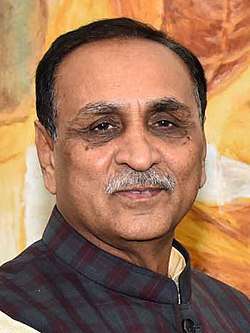 |
Gujarat | Vijay Rupani II |
|
| 5. | Manohar Lal Khattar | 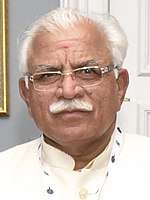 |
Haryana | Manohar Lal Khattar II |
|
| 6. | Jai Ram Thakur | .jpg) |
Himachal Pradesh | Jai Ram Thakur I |
|
| 7. | B. S. Yediyurappa |  |
Karnataka | B. S. Yediyurappa IV |
|
| 8. | Shivraj Singh Chouhan | .jpg) |
Madhya Pradesh | Shivraj Singh Chouhan IV | |
| 9. | N. Biren Singh |  |
Manipur | N. Biren Singh I | |
| 10. | Biplab Kumar Deb | 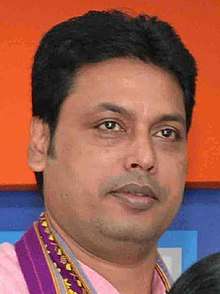 |
Tripura | Biplab Kumar Deb I |
|
| 11. | Yogi Adityanath | 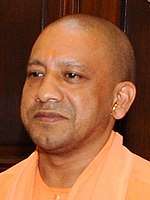 |
Uttar Pradesh | Yogi Adityanath I | |
| 12. | Trivendra Singh Rawat | 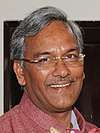 |
Uttarakhand | Trivendra Singh Rawat I |
|
List of Deputy Chief Ministers
| S.No | State | Name | Portrait |
|---|---|---|---|
| 1. | Arunachal Pradesh | Chowna Mein | .jpg) |
| 2. | Bihar | Sushil Kumar Modi | .jpg) |
| 3. | Goa | Manohar Ajgaonkar | |
| 4. | Chandrakant Kavlekar | ||
| 5. | Gujarat | Nitinbhai Patel | |
| 6. | Karnataka | C. N. Ashwath Narayan |  |
| 7. | Govind Karjol | ||
| 8. | Laxman Savadi | 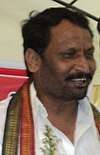 | |
| 9. | Nagaland | Yanthungo Patton | .jpg) |
| 10. | Tripura | Jishnu Dev Varma | .jpg) |
| 11. | Uttar Pradesh | Dinesh Sharma |  |
| 12. | Keshav Prasad Maurya |
See also
- List of political parties in India
- Politics of India
- List of presidents of the Bharatiya Janata Party
- List of current state presidents of the Bharatiya Janata Party
- Leader of the Bharatiya Janata Party in the Parliament of India
- National Executive of the Bharatiya Janata Party
- State units of the Bharatiya Janata Party
References
Notes
- Sharma (2019), p. 523: "First, citizenship status biased towards religious identity is by no means a new idea.... A careful study of the policies and laws related to citizenship, adopted since independence substantiate the assertion that citizenship in India has always been based on an implicit belief that India is for Hindus."
- Sen (2018), pp. 10–11: "Nehru’s response [to Patel's warning] made it clear that Muslim migrants from Pakistan could not join the ranks of refugees in India... Thus, despite broad public statements promising citizenship to all displaced persons from Pakistan, Hindu migrants alone counted as citizen-refugees in post-partition India."
- Jayal (2019), pp. 34–35: "While some elements of religious difference had... been covertly smuggled in earlier, this bill seeks to do so overtly."
- The BJP does not however currently have any elected MLAs in the state
Citations
- Ananya Das (20 January 2020). "Jagat Prakash Nadda: BJP's new national president rises through the ranks, faces several challenges". Zee News. Retrieved 16 March 2020.
- Gyan Varma (15 July 2019). "Meet BL Santhosh, newly appointed general secretary of BJP". live mint. Retrieved 16 March 2020.
- "Bharatiya Janata Party Constitution". BJP official website. Bharatiya Janata Party. Archived (PDF) from the original on 18 November 2017. Retrieved 15 May 2020.
- "BJP announces new parliamentary committee; Modi leader in Lok Sabha, Rajnath his deputy". India Today. 12 June 2019. Retrieved 16 March 2020.
- "What you need to know about India's BJP". AlJazeera. 23 May 2019. Retrieved 16 March 2020.
- "BJP's foundation day: Brief history of the achievements and failures of the party". The Indian Express. 6 April 2019. Retrieved 17 March 2020.
- "BJP Gets A New Address; Soul of New Office Is The Party Worker, Says PM Modi".
- Siddhartha Rai (27 January 2017). "PM Modi goes cashless, buys lifetime subscription of BJP mouthpiece Kamal Sandesh through cheque". India Today. Retrieved 17 March 2020.
- "Public Policy Research Centre". Retrieved 22 July 2020.
- —Express News Service (23 May 2020). "BJP think tank offers online course in governance; babus to impart lessons". newindianexpress.com. New Delhi: The New Indian Express. Retrieved 14 July 2020.
—"BJP think tank releases Modi Govt's 100-day report card". dailypioneer.com. New Delhi: The Pioneer. 10 September 2019. Retrieved 14 July 2020.Public Policy Research Center (PPRC), BJP’s think tank, on Monday released a comprehensive report on 100 major decisions and initiatives taken by Modi Government in first 100 days.
- Srijan Shukla and Neelam Pandey (30 December 2019). "How the Right is tackling Left's intellectual hegemony in Delhi – one think-tank at a time". The Print. Retrieved 17 March 2020.
- "Akhil Bhartiya Vidyarthi Parishad is not the students' wing of BJP: Shreehari Borikar".
- "BJP youth wing launches its campaign for party's Lok Sabha poll win". Economic Times. 19 January 2019. Retrieved 17 March 2020.
- "Quota for women in council of ministers among Mahila Morcha's suggestions for BJP poll manifesto". Economic Times. 5 April 2019. Retrieved 17 March 2020.
- Pragya Singh (15 January 2008). "Need to Know BJP-led BMS is biggest labour union in India". live mint. Retrieved 17 March 2020.
- Rajkumar. "सरकार की नीतियों को किसानों तक पहुंचाएगा बीजेपी किसान मोर्चा". m.patrika.com. Retrieved 8 August 2020.
- —"BJP inducts 7 crore new members, creates membership drive record". India Today. 29 August 2019. Retrieved 29 August 2019.
—"BJP to add 7 crore new members: J P Nadda". The Times of India. 29 August 2019. Retrieved 29 August 2019. - Johnson, Matthew; Garnett, Mark; Walker, David M (2017). Conservatism and Ideology. Routledge. pp. 45–50. ISBN 978-1-317-52900-2.
- Chatterji, Angana P.; Hansen, Thomas Blom; Jaffrelot, Christophe (2019). Majoritarian State: How Hindu Nationalism Is Changing India. Oxford University Press. pp. 100–130. ISBN 978-0-190-07817-1.
- Taylor, McComas (2016). Seven Days of Nectar: Contemporary Oral Performance of the Bhagavatapurana. Oxford University Press. p. 197. ISBN 978-0-190-61192-7.
- Bonikowska, Monika (2014). "India After The Elections". Centre for International Relations (6): 2. Archived from the original on 24 September 2017. Retrieved 24 September 2017.
- —Rao Jr., Parsa Venkateshwar (18 January 2016). "Modi's right-wing populism". Daily News and Analysis. Archived from the original on 1 July 2017. Retrieved 29 June 2017.
—Wodak, Ruth; KhosraviNik, Majid; Mral, Brigitte (2013). Right-Wing Populism in Europe: Politics and Discourse. A&C Black. p. 23. ISBN 978-1-780-93343-6. - Kale, Sunila (2014). Electrifying India: Regional Political Economies of Development. Stanford University Press. p. 94. ISBN 978-0-804-79102-1.
- "Bharatiya Janata Party (BJP)". elections.in. Retrieved 21 August 2019.
- Malik & Singh 1992, pp. 318–336; Banerjee 2005, p. 3118; BBC 2012.
- Pillalamarri, Akhilesh. "India's Bharatiya Janata Party Joins Union of International Conservative Parties — The Diplomat". The Diplomat. Archived from the original on 28 February 2016.
- "Members". idu.org. International Democrat Union. Retrieved 25 September 2019.
- "International Democrat Union » Asia Pacific Democrat Union (APDU)". International Democrat Union. Archived from the original on 16 June 2017. Retrieved 12 June 2017.
- "Gujarat deputy CM welcomes all Congress MLAs to join Saffron party". Business Insider. 17 March 2020. Retrieved 17 March 2020.
- Election Commission 2013.
- Devesh Kumar (20 May 2014). "BJP + 29 Parties = National Democratic Alliance". NDTV. Retrieved 17 March 2020.
- "BJP seals alliances in Northeast, aims 22 LS seats". The Hindu Business Line. 13 March 2019. Retrieved 17 March 2020.
- Party Position pdf
- "ALPHABETICAL PARTY POSITION IN THE RAJYA SABHA".
- "STRENGTHWISE PARTY POSITION IN THE RAJYA SABHA". Rajya Sabha. Archived from the original on 6 June 2017.
- "BJP gains back Madhya Pradesh in just 15 months after losing it". India Today. 26 November 2019.
- "Lok Sabha Election results 2019: EC declares results of all 542 seats, BJP wins 303". Zee News. 25 May 2019. Retrieved 30 March 2020.
- "In Numbers: The Rise of BJP and decline of Congress". The Times of India. 19 May 2016. Archived from the original on 5 November 2017. Retrieved 29 June 2017.
- "BJP inducts 7 crore new members, creates membership drive record". India Today. 29 August 2019. Retrieved 29 August 2019.
- Banerjee 2005, p. 3118.
- Malik & Singh 1992, p. 318.
- "Men, machinery and mind of RSS behind BJP's poll power punch". Business Standard. 17 March 2019. Retrieved 18 March 2020.
- Swain, Pratap Chandra (2001). Bharatiya Janata Party: Profile and Performance. APH Publishing. p. 60. ISBN 9788176482578.
- Guha 2007, p. 633.
- Sen 2005, pp. 251–272.
- Noorani 1978, p. 216.
- Jaffrelot 1996, pp. 116–119.
- Guha 2007, p. 136.
- Guha 2007, p. 250.
- Jaffrelot 1996, pp. 122–126, 129–130.
- Guha 2007, pp. 250, 352, 413.
- Guha 2007, pp. 427–428.
- Guha 2007, pp. 538–540.
- Jaffrelot 1996, pp. 282–283.
- Jaffrelot 1996, pp. 292–301, 312.
- Jaffrelot 1996, pp. 301–312.
- Malik & Singh 1992, pp. 318–336.
- Guha 2007, p. 579.
- Pai 1996, pp. 1170–1183.
- Jha 2003.
- Flint 2005, p. 165.
- Guha 2007, pp. 582–598.
- Guha 2007, pp. 635.
- Reddy 2008.
- Guha 2007, pp. 636.
- Guha 2007, pp. 633–659.
- NDTV 2012.
- Al Jazeera 2009.
- Venkatesan 2005.
- Jones 2013.
- Sen 2005, p. 254.
- rediff.com 1998.
- Outlook 2013.
- Outlook 2012.
- Kattakayam 2012.
- India Today 2001.
- Tehelka 2001.
- Ghassem-Fachandi 2012, pp. 1–31.
- Jaffrelot 2013, p. 16.
- Harris 2012.
- Krishnan 2012.
- Hindustan Times 2014.
- NDTV.com 2012.
- "Naroda Patiya verdict: Gujarat HC acquits Maya Kodnani, commutes Babu Bajrangi's sentence". India Today. 20 April 2018. Retrieved 6 June 2018.
- Brass 2005, pp. 385–393.
- Gupta 2011, p. 252.
- Nussbaum 2008, p. 2.
- Ramesh 2004.
- The Hindu 2004.
- Hindustan Times 2009.
- Mathew 2014.
- Deccan Chronicle 2014.
- BBC & May 2014.
- Sridharan 2014.
- Times of India 2014.
- Diwakar 2014.
- Varshney 2014.
- Akhtar, Rais; Kirk, William. "Jammu and Kashmir, State, India". Encyclopædia Britannica. Retrieved 7 August 2019.
Jammu and Kashmir, state of India, located in the northern part of the Indian subcontinent in the vicinity of the Karakoram and westernmost Himalayan mountain ranges. The state is part of the larger region of Kashmir, which has been the subject of dispute between India, Pakistan, and China since the partition of the subcontinent in 1947.
- Osmańczyk, Edmund Jan (2003). "Jammu and Kashmir.". In Mango, Anthony (ed.). Encyclopedia of the United Nations and International Agreements. 2: G–M (3rd ed.). Taylor & Francis. p. 1189. ISBN 978-0-415-93922-5.
Territory in northwestern India, subject of a dispute between India and Pakistan. It has borders with Pakistan and China.
- Citizenship Amendment Bill: India's new 'anti-Muslim' law explained, BBC News, 11 December 2019.
- "Parliament passes the Citizenship (Amendment) Bill 2019". pib.gov.in. Retrieved 18 December 2019.
- Slater, Joanna (18 December 2019). "Why protests are erupting over India's new citizenship law". The Washington Post. Archived from the original on 18 December 2019. Retrieved 18 December 2019.
- National Informatics Centre 2014.
- Election Commission 1984.
- Election Commission 1989.
- Election Commission 1991.
- Election Commission 1996.
- Election Commission 1998.
- Election Commission 1999.
- Election Commission 2004.
- Election Commission 2009.
- Election Commission 2014.
- Election Commission 2019.
- Hansen 1999, p. 85.
- Swain 2001, pp. 71–104.
- Seshia 1998, pp. 1036–1050.
- Gillan 2002, pp. 73–95.
- Sen 2005, p. 63.
- International Religious Freedom Report 2005.
- The Hindu 2002.
- Davies 2005.
- BBC & January 2014.
- Fitzgerald 2011, pp. 67–68.
- Vajpayee 2007, pp. 318–342.
- Ramachandran 2003.
- Times of India 2013.
- Buncombe 2014.
- Ramaseshan 2013.
- Business Standard 2014.
- "Meet the BJP leader who released a book on LGBT rights". The News Minute. 14 July 2014. Archived from the original on 31 October 2016. Retrieved 30 March 2017.
- "It's a great honour to be awarded for book on gender variants: Gopi Shankar". Timesofindia.indiatimes.com. 21 July 2014. Archived from the original on 7 January 2017. Retrieved 30 March 2017.
- Ashok Row Kavi (19 March 2016). "RSS flip-flop on homosexuality indicates gay men in India remain in exile, writes Ashok Row Kavi". Firstpost.com. Archived from the original on 28 March 2017. Retrieved 30 March 2017.
- "BJP leader launches LGBT rights book in TN". Mumbai Mirror. Archived from the original on 3 March 2016. Retrieved 23 May 2017.
- "'It Will Give Rise to HIV Cases': Subramanian Swamy Frowns at SC Verdict on Section 377". News18 India. 6 September 2018.
- Shulman 2000, pp. 365–390.
- Tiwari 2012.
- Guha 2007, pp. 710–720.
- Sen 2005, p. 70.
- Sheela Bhatt 2014.
- Bobbio 2012, pp. 652–668.
- Jaffrelot 2013, pp. 79–95.
- "Atal Bihari Vajpayee, The Man Who Mainstreamed BJP And Bharatiyata". Swarajya. 16 August 2018.
- "Modi rolls out his populist plans with a second term in mind". The Nikkei.
- Ganguly 1999, pp. 148–177.
- Krishnan 2004, pp. 1–37.
- Kux 2002, pp. 93–106.
- Qadir 2002, pp. 1–10.
- Abbas 2004, p. 173.
- Times of India 2002.
- Chaulia 2002, pp. 215–234.
- Harris 2005, pp. 7–27.
- Lall 2006.
- Times of India 2012.
- First Post 2015.
- "BJP becomes largest political party in the world", The Times of India, 30 March 2015, archived from the original on 6 December 2016
- World Statesman 2014.
- Pisharoty, Sangeeta Barooah (25 May 2016). "BJP Crafts North East Democratic Alliance to Make the Region 'Congress Mukt'". Archived from the original on 26 May 2016.
- "Amit Shah holds meeting with northeast CMs, forms alliance". 25 May 2016. Archived from the original on 26 May 2016.
- "BJP Acts East With New Anti-Congress Bloc, Puts Himanta Biswa in Charge". Archived from the original on 25 May 2016.
Sources
- Sharma, Chetna (2019), "Citizenship Amendment Bill 2016: Continuities and contestations with special reference to politics in Assam, India", Asian Ethnicity, 20 (4): 522–540, doi:10.1080/14631369.2019.1601993
- Sen, Uditi (2018), Citizen Refugee: Forging the Indian Nation after Partition, Cambridge University Press, ISBN 978-1-108-42561-2
- Jayal, Niraja Gopal (2013), Citizenship and its Discontents: An Indian History, Harvard University Press, ISBN 978-0-674-06758-5
- Jayal, Niraja Gopal (2019), "Reconfiguring Citizenship in Contemporary India", South Asia: Journal of South Asian Studies, 42 (1): 33–50, doi:10.1080/00856401.2019.1555874, ISSN 0085-6401
- Abbas, Hassan (2004). Pakistan's Drift into Extremism: Allah, The Army, And America's War on Terror. M.E. Sharpe. ISBN 978-0-7656-1497-1.CS1 maint: ref=harv (link)
- "Uproar over India mosque report: Inquiry into Babri mosque's demolition in 1992 indicts opposition BJP leaders". Al Jazeera. 24 November 2009. Retrieved 8 July 2014.
- Banerjee, Sumanta (16–22 July 2005). "Civilising the BJP". Economic & Political Weekly. 40 (29): 3116–3119. JSTOR 4416896.CS1 maint: ref=harv (link)
- "Narendra Modi sworn in as Indian prime minister". BBC News. 26 May 2014. Retrieved 26 May 2014.
- "Indian Astrology vs Indian Science". BBC World Service. Retrieved 17 January 2014.
- Bhatt, Abhinav (28 December 2014). "Raghubar Das Sworn-In as Jharkhand Chief Minister, PM Modi Misses Ceremony Due to Fog in Delhi". NDTV. Retrieved 2 June 2015.
- Bhatt, Sheela. "What Anandiben Patel is really like". Rediff. Retrieved 27 June 2014.
- Bobbio, Tommaso (2012). "Making Gujarat Vibrant: Hindutva, development and the rise of subnationalism in India". Third World Quarterly. 33 (4): 653–668. doi:10.1080/01436597.2012.657423.CS1 maint: ref=harv (link)
- Brass, Paul R. (2005). The Production of Hindu-Muslim Violence in Contemporary India. University of Washington Press. pp. 385–393. ISBN 978-0-295-98506-0.CS1 maint: ref=harv (link)
- Buncombe, Andrew (11 July 2014). "India's gay community scrambling after court decision recriminalises homosexuality". The Independent. Retrieved 11 July 2014.CS1 maint: ref=harv (link)
- "It is the govt.'s responsibility to protect LGBT rights, says Harsh Vardhan". Business Standard. Mumbai, India. 17 July 2014. Retrieved 19 July 2014.
- Chaulia, Sreeram (June 2002). "BJP, India's Foreign Policy and the "Realist Alternative" to the Nehruvian Tradition". International Politics. 39 (2): 215–234. doi:10.1057/palgrave.ip.8897388. S2CID 144714683.CS1 maint: ref=harv (link)
- Davies, Richard (2005). "The Cultural Background of Hindutva". In Ayres & Oldenburg, Alyssa & Philip (ed.). India Briefing; Takeoff at Last?. Asia Society.
- "Narendra Modi to be sworn in as 15th Prime Minister of India on May 26". Deccan Chronicle. 20 May 2014. Retrieved 26 May 2014.
- Diwakar, Rekha (2014). "The 16th general election in India, April–May 2014". Electoral Studies. 37: 1–6. doi:10.1016/j.electstud.2014.11.005.CS1 maint: ref=harv (link)
- "General Election to Lok Sabha Trends and Results". Election Commission of India. Retrieved 18 June 2014.
- "List of Political Parties and Election Symbols main Notification Dated 18.01.2013" (PDF). India: Election Commission of India. 2013. Retrieved 9 May 2013.
- "Statistical report on general elections, 1984 to the Eighth Lok Sabha" (PDF). Election Commission of India. Archived from the original (PDF) on 18 July 2014. Retrieved 18 July 2014.
- "Statistical report on general elections, 1989 to the Ninth Lok Sabha" (PDF). Election Commission of India. Archived from the original (PDF) on 18 July 2014. Retrieved 18 July 2014.
- "Statistical report on general elections, 1991 to the Tenth Lok Sabha" (PDF). Election Commission of India. Archived from the original (PDF) on 18 July 2014. Retrieved 18 July 2014.
- "Statistical report on general elections, 1996 to the Eleventh Lok Sabha" (PDF). Election Commission of India. Retrieved 30 May 2014.
- "Statistical report on general elections, 1998 to the Twelfth Lok Sabha" (PDF). Election Commission of India. Archived from the original (PDF) on 18 July 2014. Retrieved 30 May 2014.
- "Statistical report on general elections, 1999 to the Thirteenth Lok Sabha" (PDF). Election Commission of India. Archived from the original (PDF) on 18 July 2014. Retrieved 30 May 2014.
- "Statistical report on general elections, 2004 to the Fourteenth Lok Sabha" (PDF). Election Commission of India. Retrieved 30 May 2014.
- "Performance of National Parties" (PDF). Election Commission of India. Retrieved 30 May 2014.
- "Statistical Report on General Election, 2013 to the Legislative Assembly of Chhattisgarh" (PDF). Election Commission of India. p. 8. Retrieved 7 January 2015.
- "Statistical Report on General Election, 2013 to the Legislative Assembly of Madhya Pradesh" (PDF). Election Commission of India. p. 12. Retrieved 7 January 2015.
- "Statistical Report on General Election, 2013 to the Legislative Assembly of Nagaland" (PDF). Election Commission of India. p. 7. Retrieved 7 January 2015.
- "Statistical Report on General Election, 2013 to the Legislative Assembly of Rajasthan" (PDF). Election Commission of India. p. 11. Retrieved 7 January 2015.
- "Haryana". Election Commission of India. Archived from the original on 3 November 2014. Retrieved 7 January 2015.
- "Maharashtra". Election Commission of India. Archived from the original on 3 November 2014. Retrieved 7 January 2015.
- Fitzgerald, Timothy (2011). Religion and Politics in International Relations: The Modern Myth. A&C Black. ISBN 9781441142900.CS1 maint: ref=harv (link)
- Flint, Colin (2005). The geography of war and peace. Oxford University Press. ISBN 978-0-19-516208-0.CS1 maint: ref=harv (link)
- Ganguly, Sumit (Spring 1999). "India's Pathway to Pokhran II: The Prospects and Sources of New Delhi's Nuclear Weapons Program". International Security. 23 (4): 148–177. doi:10.1162/isec.23.4.148. JSTOR 2539297. S2CID 57565560.CS1 maint: ref=harv (link)
- Ghassem-Fachandi, Parvis (2012). Pogrom in Gujarat: Hindu Nationalism and Anti-Muslim Violence in India. Princeton University Press. ISBN 978-0691151779.CS1 maint: ref=harv (link)
- Gillan, Michael (March 2002). "Refugees or Infiltrators? The Bharatiya Janata Party and "Illegal" Migration from Bangladesh". Asian Studies Review. 26 (1): 73–95. doi:10.1080/10357820208713331. S2CID 146522066.CS1 maint: ref=harv (link)
- Guha, Ramachandra (2007). India after Gandhi: the history of the world's largest democracy (1st ed.). India: Picador. ISBN 978-0-330-39610-3.CS1 maint: ref=harv (link)
- Gupta, Dipankar (2011). Justice before Reconciliation: Negotiating a 'New Normal' in Post-riot Mumbai and Ahmedabad. Routledge. p. 34. ISBN 978-0-415-61254-8.CS1 maint: ref=harv (link)
- Halarnkar, Samar (13 June 2012). "Narendra Modi makes his move". BBC News.
The right-wing Hindu nationalist Bharatiya Janata Party (BJP), India's primary opposition party
- Hansen, Thomas (1999). The saffron wave : democracy and Hindu nationalism in modern India. Princeton, NJ: Princeton University Press. ISBN 978-0-691-00671-0.CS1 maint: ref=harv (link)
- Harris, Gardiner (2 July 2012). "Justice and 'a Ray of Hope' After 2002 India Riots". The New York Times. Retrieved 25 February 2014.CS1 maint: ref=harv (link)
- Harris, Jerry (2005). "Emerging Third World powers: China, India and Brazil". Race & Class. 46 (7): 7–27. doi:10.1177/0306396805050014. S2CID 154768728.CS1 maint: ref=harv (link)
- "The Meaning of Verdict 2004". The Hindu. Chennai, India. 14 May 2004. Retrieved 10 December 2013.
- "Inventing History". The Hindu. 14 October 2002.
- "Modi did not incite riots: SIT". Hindustan Times. Retrieved 22 January 2014.
- "2009 Lok Sabha election: Final results tally". Hindustan Times. 17 May 2009. Retrieved 27 June 2014.
- "Tehelka sting: How Bangaru Laxman fell for the trap". India Today. Retrieved 9 May 2012.
- Jaffrelot, Christophe (1996). The Hindu Nationalist Movement and Indian Politics. C. Hurst & Co. Publishers. ISBN 978-1850653011.CS1 maint: ref=harv (link)
- Jaffrelot, Christophe (June 2013). "Gujarat Elections: The Sub-Text of Modi's 'Hattrick'—High Tech Populism and the 'Neo-middle Class". Studies in Indian Politics. 1: 2–27. doi:10.1177/2321023013482789.CS1 maint: ref=harv (link)
- Jha, Nilanjana Bhaduri (21 February 2003). "Survey shows temple remains in Ayodhya: VHP". The Times of India. Retrieved 11 July 2014.CS1 maint: ref=harv (link)
- Keith Jones (9 October 1999). "Hindu chauvinist-led coalition to form India's next government". World Socialist Web Site. Retrieved 27 September 2013.
- Kattakayam, Jiby (27 April 2012). "Bangaru Laxman convicted of taking bribe". The Hindu. Chennai, India. Retrieved 9 May 2012.CS1 maint: ref=harv (link)
- Krishnan, Jayanth (1 January 2004). "India's "Patriot Act": POTA and the Impact on Civil Liberties in the World's Largest Democracy". Faculty Publication, Indiana Law University. Retrieved 27 June 2014.
- Krishnan, Murali; Shamil Shams (11 March 2012). "Modi's clearance in the Gujarat riots case angers Indian Muslims". Deutsche Welle.
- Kux, Dennis (May–June 2002). "India's Fine Balance". Foreign Affairs. 81 (3): 93–106. doi:10.2307/20033165. JSTOR 20033165.CS1 maint: ref=harv (link)
- Lall, Marie (December 2006). "Indo-Myanmar Relations in the Era of Pipeline Diplomacy". Contemporary Southeast Asia. 28 (3). doi:10.1355/CS28-3D.CS1 maint: ref=harv (link)
- Malik, Yogendra K.; Singh, V.B. (April 1992). "Bharatiya Janata Party: An Alternative to the Congress (I)?". Asian Survey. 32 (4): 318–336. doi:10.2307/2645149. JSTOR 2645149.CS1 maint: ref=harv (link)
- Mathew, Liz (16 May 2014). "Narendra Modi makes election history as BJP gets majority on its own". Live Mint. Retrieved 26 May 2014.CS1 maint: ref=harv (link)
- Naqvi, Saba; Raman, Anuradha (1 April 2013). "Their Dark Glasses". Outlook.
- "Lok Sabha at a glance". National Informatics Centre. Archived from the original on 21 May 2014. Retrieved 17 July 2014.
- "Report: Sequence of events on December 6". NDTV. Retrieved 20 June 2012.
- "Naroda Patiya riots: Former minister Maya Kodnani gets 28 years in jail". NDTV.com. Retrieved 17 November 2012.
- Noorani, A. G. (March–April 1978). "Foreign Policy of the Janata Party Government". Asian Affairs. 5 (4): 216–228. doi:10.1080/00927678.1978.10554044. JSTOR 30171643.CS1 maint: ref=harv (link)
- Nussbaum, Martha Craven (2008). The Clash Within: Democracy, Religious Violence, and India's Future. Harvard University Press. p. 2. ISBN 978-0-674-03059-6.CS1 maint: ref=harv (link)
- "Tehelka Sting: After Eleven Years, It Stings To Say This". Outlook. Retrieved 9 May 2012.
- Pai, Sudha (December 1996). "Transformation of the Indian Party System: The 1996 Lok Sabha Elections". Asian Survey. 36 (12): 1170–1183. doi:10.1525/as.1996.36.12.01p01884. JSTOR 2645573.CS1 maint: ref=harv (link)
- Qadir, Shaukat (April 2002). "An Analysis of the Kargil Conflict 1999" (PDF). RUSI Journal. Archived from the original (PDF) on 27 March 2009. Retrieved 20 May 2009.CS1 maint: ref=harv (link)
- Ramachandran, Sujata (15 February 2003). "'Operation Pushback' Sangh Parivar, State, Slums, and Surreptitious Bangladeshis in New Delhi". Economic & Political Weekly. 38 (7): 637–647. JSTOR 4413218.
- Ramaseshan, Radhika (14 December 2013). "BJP comes out, vows to oppose homosexuality". The Telegraph. Calcutta, India. Retrieved 16 December 2013.
- Ramesh, Randeep (14 May 2004). "News World news Shock defeat for India's Hindu nationalists". The Guardian. Retrieved 10 December 2013.CS1 maint: ref=harv (link)
- "TDP helps Vajpayee wins confidence vote". Rediff.com. Retrieved 4 January 2011.
- "Thirteenth Gujarat Legislative Assembly". Government of Gujarat. Retrieved 29 May 2015.
- Sen, Amartya (2005). India and the world (1. publ. ed.). Allen Lane: 2005. ISBN 978-0-7139-9687-6.CS1 maint: ref=harv (link)
- Reddy, Sheila (14 April 2008). "Interview "I Was Prepared To Take The Risk"". Outlook India. Archived from the original on 21 May 2014.
- Seshia, Shaila (November 1998). "Divide and Rule in Indian Party Politics: The Rise of the Bharatiya Janata Party". Asian Survey. 38 (11): 1036–1050. doi:10.1525/as.1998.38.11.01p0406o.CS1 maint: ref=harv (link)
- Shulman, Stephen (September 2000). "Nationalist Sources of International Economic Integration". International Studies Quarterly. 44 (3): 365–390. doi:10.1111/0020-8833.00164.CS1 maint: ref=harv (link)
- Sridharan, Eswaran (October 2014). "India's Watershed Vote" (PDF). Journal of Democracy. 25 (4). Archived from the original (PDF) on 12 January 2015. Retrieved 23 April 2015.
- Swain, Pratap Chandra (2001). Bharatiya Janata Party: Profile and Performance. India: APH publishing. pp. 71–104. ISBN 978-81-7648-257-8. Retrieved 5 July 2014.CS1 maint: ref=harv (link)
- "Bangaru Laxman convicted for taking bribe". Tehelka. Archived from the original on 11 May 2012. Retrieved 9 May 2012.
- "Election results 2014: India places its faith in Moditva — The Times of India". Timesofindia.indiatimes.com. 17 May 2014. Retrieved 11 August 2014.
- "SP condemns Vaiko's arrest under Pota". The Times of India. 13 July 2002.
- "BJP amends constitution allowing Gadkari to get a second term". The Times of India. 28 September 2012. Retrieved 4 April 2014.
- "Stand with RSS, BJP". The Times of India. 20 December 2013. Retrieved 13 March 2014.
- Chatterjee, Mohua (13 July 2015). "BJP enrolls 11 crore members, launches 'Mahasampark Abhiyan'". First Post.
- Tiwari, Aviral Kumar (March 2012). "An Error-Correction Analysis of India-Us Trade Flows". Journal of Economic Development. 37 (1).CS1 maint: ref=harv (link)
- "India: International Religious Freedom Report". US Department of state. Retrieved 11 August 2014.
- Vajpayee, Atal Bihari (2007). Jaffrelot, Christophe (ed.). Hindu Nationalism: A Reader. Delhi: Permanent Black. ISBN 9780691130989. Missing or empty
|title=(help)CS1 maint: ref=harv (link) - Varshney, Ashutosh (October 2014). "Hindu Nationalism in Power?". Journal of Democracy. 25 (4): 34–45. doi:10.1353/jod.2014.0071. S2CID 144608424.CS1 maint: ref=harv (link)
- Venkatesan, V. (16–29 July 2005). "In the dock, again". Frontline. 22 (15). Retrieved 28 June 2014.CS1 maint: ref=harv (link)
Further reading
- Ahuja, Gurdas M. (2004). Bharatiya Janata Party and Resurgent India. Ram Company.
- Andersen, Walter K.; Damle, Shridhar D. (1987) [Originally published by Westview Press]. The Brotherhood in Saffron: The Rashtriya Swayamsevak Sangh and Hindu Revivalism. Delhi: Vistaar Publications.
- Baxter, Craig (1971) [first published by University of Pennsylvania Press 1969]. The Jana Sangh — A Biography of an Indian Political Party. Oxford University Press, Bombay. ISBN 978-0812275834.
- Graham, B. D. (1990). Hindu Nationalism and Indian Politics: The Origins and Development of the Bharatiya Jana Sangh. Cambridge University Press. ISBN 978-0-521-383486.
- Malik, Yogendra K.; Singh, V.B. (1994). Hindu Nationalists in India : The Rise of the Bharatiya Janata Party. Boulder, Colorado: Westview Press. ISBN 978-0-8133-8810-6.
- Jaffrelot, Christophe (1996). The Hindu Nationalist Movement and Indian Politics. C. Hurst & Co. Publishers. ISBN 978-1850653011.
- Mishra, Madhusudan (1997). Bharatiya Janata Party and India's Foreign Policy. New Delhi: Uppal Pub. House. ISBN 978-81-85565-79-8.
- Sharma, C.P. Thakur, Devendra P. (1999). India under Atal Behari Vajpayee : The BJP Era. New Delhi: UBS Publishers' Distributors. ISBN 978-81-7476-250-4.
- Bhambhri, C.P. (2001). Bharatiya Janata Party : Periphery to Centre. Delhi: Shipra. ISBN 978-81-7541-078-7.
- Jaffrelot, Christophe (July 2003). "Communal Riots in Gujarat: The State at Risk?" (PDF). Heidelberg Papers in South Asian and Comparative Politics: 16. Retrieved 5 November 2013.
- Nag, Kingshuk (2014). The Saffron Tide: The Rise of the BJP. Rupa Publications. ISBN 978-8129134295.
- Stein, Burton (2010). A history of India (edited by David Arnold. 2nd ed.). Chichester, UK: Wiley-Blackwell. ISBN 978-1-4051-9509-6.
- Rao, Ramesh (2001). Coalition conundrum: the BJP's trials, tribulations, and triumphs. Har Anand. ISBN 9788124108093.
External links
| Wikimedia Commons has media related to: |

